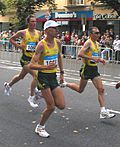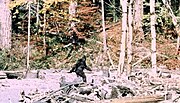A gait is a manner of limb movements made during locomotion. Human gaits are the various ways in which humans can move, either naturally or as a result...
36 KB (4,877 words) - 16:42, 5 June 2024
Gait is the pattern of movement of the limbs of animals, including humans, during locomotion over a solid substrate. Most animals use a variety of gaits...
13 KB (1,645 words) - 07:32, 12 July 2024
various gaits (patterns of leg movement) during locomotion across solid ground, either naturally or as a result of specialized training by humans. Gaits are...
26 KB (3,754 words) - 02:55, 29 May 2024
The gunslinger's gait or KGB walk is a walking pattern observed in individuals associated with the KGB or the Red Army.[citation needed] It is a standard...
3 KB (339 words) - 14:15, 27 March 2024
location Alexander Technique Contortionism Ergonomics Feldenkrais Method Gait (human) Human anatomical terms Mitzvah Technique Neutral spine Positional asphyxia...
19 KB (2,232 words) - 01:09, 4 July 2024
Terrestrial locomotion (redirect from Saltation (gait))
move backward much faster than they can move forward. Gait analysis is the study of gait in humans and other animals. This may involve videoing subjects...
32 KB (4,158 words) - 01:20, 12 July 2024
Gait analysis is the systematic study of animal locomotion, more specifically the study of human motion, using the eye and the brain of observers, augmented...
24 KB (2,935 words) - 09:11, 17 July 2024
An ambling gait or amble is any of several four-beat intermediate horse gaits, all of which are faster than a walk but usually slower than a canter and...
34 KB (4,339 words) - 21:47, 21 June 2024
Walking (redirect from Tripod gait)
is one of the main gaits of terrestrial locomotion among legged animals. Walking is typically slower than running and other gaits. Walking is defined...
56 KB (7,195 words) - 00:55, 21 July 2024
Trendelenburg gait, named after Friedrich Trendelenburg, is an abnormal human gait. It is caused by weakness or ineffective action of the gluteus medius...
6 KB (632 words) - 17:53, 8 July 2024
specifically adapted for efficient bipedal gait. While the capacity to walk upright is not unique to humans, other primates can only achieve this for short...
72 KB (8,980 words) - 08:03, 27 May 2024
up gait in Wiktionary, the free dictionary. Gait is the pattern of limb movement during locomotion. Gait may also refer to: Gait (human) Canine gait Horse...
629 bytes (108 words) - 20:10, 22 March 2016
ability to use fire would not have allowed global dispersal. This change in gait saw a lengthening of the legs proportionately when compared to the length...
264 KB (26,481 words) - 04:59, 22 July 2024
of gait also aids balance. An increase in leg length since the evolution of bipedalism changed how leg muscles functioned in upright gait. In humans, the...
21 KB (2,646 words) - 02:00, 16 May 2024
Parkinsonian gait (or festinating gait, from Latin festinare [to hurry]) is the type of gait exhibited by patients with Parkinson's disease (PD). It is...
37 KB (4,424 words) - 02:43, 28 March 2024
Ataxia (redirect from Ataxic gait)
consisting of lack of voluntary coordination of muscle movements that can include gait abnormality, speech changes, and abnormalities in eye movements, that indicates...
55 KB (5,946 words) - 19:26, 24 June 2024
Preferred walking speed (redirect from Human walking speed)
speed that minimizes their gross cost of transport. Among other gait costs that human walkers choose to minimize, this observation has led many to suggest...
17 KB (2,405 words) - 21:04, 23 July 2024
Wikimedia Commons has media related to Sole (foot). Barefoot Footprint Gait (human) Human skeletal changes due to bipedalism Ross & Lamperti 2006, pp. 418,...
13 KB (1,396 words) - 21:20, 21 July 2024
The timeline of human evolution outlines the major events in the evolutionary lineage of the modern human species, Homo sapiens, throughout the history...
87 KB (3,541 words) - 19:28, 2 June 2024
England as a way to allow pedestrians to laugh in a stressful time. Gait (human) Gait analysis "John Cleese and Mick Jagger are wrong – Monty Python's silly...
17 KB (2,226 words) - 17:20, 29 May 2024
that typically lasts 25–35 days. Humans are bipedal and move by walking. Human walking corresponds to the bipedal gait cycle, which involves alternating...
55 KB (6,370 words) - 23:38, 20 July 2024
Lordosis (category Human back)
bent-waist" gait. As such, lordosis in the human spine is considered one of the primary physiological adaptations of the human skeleton that allows for human gait...
26 KB (3,202 words) - 20:18, 2 June 2024
Foot (redirect from Human foot)
refers to how the body distributes weight as it cycles through the gait. During the gait cycle the foot can pronate in many different ways based on rearfoot...
28 KB (3,444 words) - 13:54, 13 July 2024
or, more frequently, after sustaining an injury or disability. Normal human gait is a complex process, which happens due to co-ordinated movements of the...
22 KB (3,117 words) - 16:04, 1 February 2024
Foot drop (category Gait abnormalities)
Foot drop is a gait abnormality in which the dropping of the forefoot happens due to weakness, irritation or damage to the deep fibular nerve (deep peroneal)...
22 KB (2,684 words) - 06:48, 10 July 2024
Bipedalism (redirect from Bipedal gait)
bipedal gait. Several lizard species move bipedally when running, usually to escape from threats. Many primate and bear species will adopt a bipedal gait in...
80 KB (9,557 words) - 14:34, 27 June 2024
locomotion. However, true wheels and propellers—despite their utility in human vehicles—do not play a significant role in the movement of living things...
61 KB (5,825 words) - 15:21, 13 March 2024
definitive text on human gait", Human Walking. They operate the Motion and Gait Analysis Lab at Stanford University. They conducted a high-tech human-replication...
96 KB (13,380 words) - 04:28, 7 July 2024
A (bipedal) gait cycle is the time period or sequence of events or movements during locomotion in which one foot contacts the ground to when that same...
8 KB (1,153 words) - 08:30, 17 June 2024
movement is a method of human locomotion that makes use of all four limbs. It is one of the earliest gaits learned by human infants, and has similar...
9 KB (1,075 words) - 14:20, 30 June 2024






















